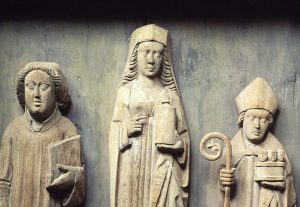An update from the Mapping Lived Religion project: Work on the public interface and a project retreat
2023-11-29
Our latest project retreat was held at Korrö – once the property of the Växjö diocese – in the deepest woods of Småland, Sweden, in October. There, we discussed the updates to the upcoming public interface’s Explore function, as well as made decisions regarding the Advanced Search function. We also discussed quality control connected to our research question of lived religion. This post briefly highlights our work during that workshop as well as over the past year. All of our core project members were there, as well as our postdoc and current research assistant.
In terms of the Explore interface, we considered aspects related to its visual appearance, and the terms to be used in the headings and other fields. We also tested the implementation of the “functional period” on the timeline. It was deemed necessary to enable searching in our quotes and transcriptions, as well as see more options to search in “type of place”. Many questions for the advisory board were noted, for when they test the interface, and this aspect of the database is nearing completion.

The project members taking a well-deserved break from their intense workshopping in lovely Korrö (Sweden).
Regarding the development and implementation of the Advanced Search function, a suggested placement was proposed that we decided works fine: a user gains access to this via the Explore interface. In this respect, we had to decide what properties should be searchable and how many different fields that we wanted to search in. For instance, we discussed that we needed to be able to search for whether or not an object is extant and more clearly search for the names of different people (other than saints). Of course, it will be possible to search for multiple saints via this function too, as well as in the transcriptions and quotes that have been input into the database.
When updates have been made to both of these functions, the public interface will be sent to our advisory board for feedback.
In addition to questions regarding the Swedish mirror site, and the possibility of a Finnish page, our discussions, as is usual, centred around quality control and how to make sure our data is reliable. As envisioned at the start of the project, it would be impossible to be as comprehensive as we would like given the relatively short period of time allotted to the project. Our focus on lived religion has necessitated excluding some data, such as church floor plans, that we do find interesting and potentially useful in other respects. In other cases, the short articles that we have written and included in the “Comment” field for cult manifestations and quotes/transcriptions might be more to the point than we had first envisioned. However, we have accomplished a great deal in the past (nearly) five years, and the resource will give access to diverse data about the cults of saints in medieval Sweden and Finland – mapped and visualized in a new way – providing new insights into lived religion via the lens of the cults of saints in the former church province.
Our aim is to be able to launch the resource Mapping Saints for public use in June 2024, while the autumn of 2024 will be spent on adding comments or short passages illuminating and explaining the data further. Next year will also be spent writing articles about the development of the digital resource, and finishing our forthcoming anthology, written together with our sister project.


Recent Comments